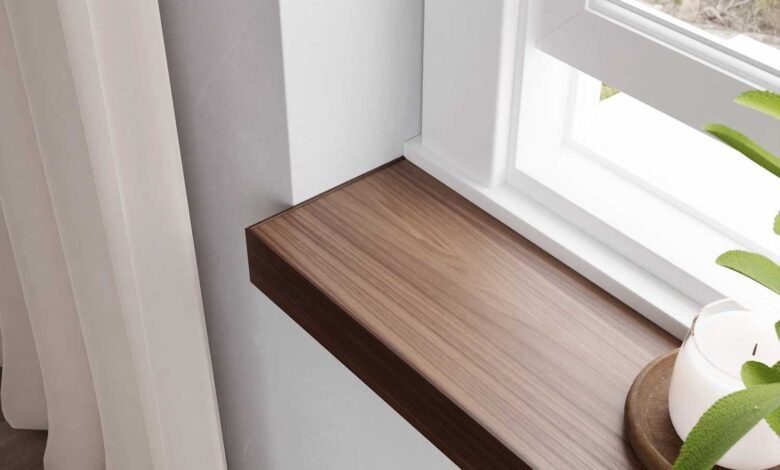Window Sill: The Overlooked Element That Transforms Your Space

Introduction to Window Sills: More Than Just a Ledge
When you think about home design or renovation, window sills probably aren’t the first thing that comes to mind. Yet, this humble architectural feature plays a far more important role than you might realize. Whether it’s wood, stone, vinyl, or tile, the window sill adds function, beauty, and personality to any room it’s a part of.
A window sill is the flat horizontal surface found at the bottom of a window. It may look simple, but it’s vital for structural support, moisture protection, and even interior aesthetics. People often decorate their sills with plants, photos, or books—but beyond that, they act as a barrier to water, dust, and drafts.
Interestingly, window sills are sometimes mistaken for window stools (the inner trim), but they’re not the same. A sill is part of the window’s frame, extending from inside to outside, while a stool is mostly decorative. That little difference can matter a lot, especially during renovations.
The Functional Role of a Window Sill
Though small in size, window sills have big responsibilities. They are a line of defense against weather, and they also help maintain the structural integrity of your windows. If you remove or ignore a damaged window sill, you’re risking serious water damage inside your walls.
Water runoff is one of the biggest challenges windows face, especially in rainy or snowy climates. A properly sloped exterior sill channels water away from the wall, reducing the risk of leaks or rot. For homes in storm-prone areas, this feature is practically essential.
On the interior, the window sill adds strength to the window frame and provides a flat, usable surface. Some people turn their sills into mini greenhouses, others use them as cozy nooks for their cats. Whatever the case, without a strong sill, the window itself could weaken over time due to shifting or sagging.
Types of Window Sills: From Classic to Contemporary
Window sills come in a variety of materials, and the best one depends on your needs, style preferences, and budget. Here are some common types:
- Wooden sills are classic and warm, often used in traditional or farmhouse-style homes. They’re easy to paint or stain but require sealing and maintenance to prevent warping or mold.
- Stone or marble sills are luxurious, durable, and moisture-resistant, perfect for kitchens, bathrooms, or upscale interiors. They’re more expensive but offer high-end appeal.
- Vinyl and PVC sills are low-maintenance, affordable, and great for humid areas. They may not have the character of wood or stone but work well in modern and minimalist settings.
- Tile sills are creative and customizable, allowing for colorful designs that match bathroom or kitchen décor.
Each type has its pros and cons, so it’s worth thinking about the environment they’ll be in. A sunny kitchen may benefit from a marble sill, while a kid’s bedroom might do better with a painted wood one.
Window Sill Decoration Ideas: Bring It to Life
Beyond function, the window sill is a surprisingly versatile space when it comes to home decor. With a little creativity, you can turn it into a stylish and personal feature of your home.
Plant lovers often use window sills as indoor garden spots. Succulents, herbs, or small flowering plants thrive here because they get plenty of sunlight. You can even hang mini planters from the sill’s edge or install a small greenhouse-style covering for protection.
If you’re more into aesthetic vibes, consider styling your sill with candles, small sculptures, or even seasonal decorations. Fairy lights, picture frames, and books add charm and warmth to your room. It’s also a great way to express your personality without committing to a full-blown room makeover.
Minimalist? No problem. Keep it clean and simple with just one statement item—like a vintage clock or a single vase. The key is making sure your window sill matches the overall look of the space, whether it’s boho, industrial, rustic, or contemporary.
Window Sills in Modern Architecture
In modern architecture, the role of the window sill has evolved, but it hasn’t disappeared. While traditional wooden sills may be less common, their sleek, minimalist counterparts are rising in popularity. Today’s designs often integrate sills directly into the window unit or the wall, creating a seamless transition between inside and out.
In some homes, especially those with large panoramic or floor-to-ceiling windows, sills are minimized or hidden completely. Instead, designers focus on flow, light, and openness. Still, even in these cases, a well-designed sill is hiding in plain sight—doing its job without drawing attention.
Sills are also part of sustainable architecture. Green builders now use materials like recycled wood, composite stone, or eco-friendly PVC to reduce the environmental footprint. Paired with energy-efficient window glass, the right sill can help improve insulation and reduce heating costs.
Common Window Sill Issues and Fixes
Like any other part of the home, window sills can wear down over time. The most common issue? Water damage. If a sill isn’t sealed properly or is made of a material prone to rot, it can absorb moisture, leading to mold, swelling, or even structural failure.
Cracks, peeling paint, or visible gaps between the window and the sill are all signs of trouble. The good news is, many of these problems can be fixed easily with caulk, wood filler, or a full sill replacement if necessary.
Regular cleaning and sealing—especially for wooden sills—can help extend their lifespan. If you’re dealing with persistent condensation on your windows, consider installing better ventilation or double-glazed windows to protect the sill and surrounding area.
Installing or Replacing a Window Sill: DIY or Professional?
Thinking about replacing or adding a window sill? If you’re handy with tools, it’s a doable weekend project. You’ll need the right measurements, basic carpentry skills, and tools like a saw, level, adhesive, and sealant.
Start by removing the old sill (if any), measure your opening, and cut the new material to fit. Apply construction adhesive, make sure it slopes outward (for drainage), and seal it with weatherproof caulk.
However, if your windows are part of a load-bearing wall, or you’re dealing with stone or marble materials, it’s wise to call in a pro. A poorly installed sill can cause long-term problems, so better safe than sorry.
Conclusion: Small Detail, Big Impact
The window sill may not be the flashiest part of your home, but it’s definitely one of the most useful. From protecting your interiors from water to adding charm and character, it plays a quiet yet essential role in both function and design.
Whether you’re renovating, redecorating, or just paying more attention to the little things, don’t overlook your window sills. Choose the right material, keep them clean and sealed, and let your personality shine through your décor. You’d be surprised how much difference a well-crafted sill can make to a room.



